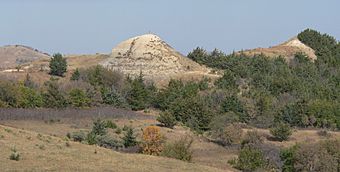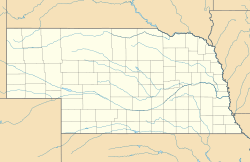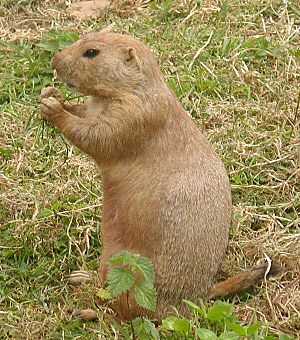Old Baldy (Lynch, Nebraska) facts for kids
Quick facts for kids |
|
|
The Tower
|
|

Old Baldy, seen from the southeast
|
|
| Nearest city | Lynch, Nebraska |
|---|---|
| Area | 1,082 acres (438 ha) |
| NRHP reference No. | 04001413 |
| Added to NRHP | December 29, 2004 |
Old Baldy, also known as the Tower, is a special hill near Lynch. It is located in Boyd County, in the northern part of Nebraska. This area is in the Midwestern United States.
In 1804, the famous Lewis and Clark Expedition visited Old Baldy. They were traveling up the Missouri River. Near the hill, they found a group of prairie dogs. These animals were new to science at that time.
Old Baldy is important because of its connection to Lewis and Clark. Also, it looks much the same as it did in 1804. Because of this, the site was added to the National Register of Historic Places in 2004.
Contents
About Old Baldy Hill
Old Baldy is located about 7 miles (11 km) north of Lynch, Nebraska. It is also about half a mile (about a kilometer) south of the Missouri River. The hill is part of a line of bluffs. These bluffs are at the southern edge of the Missouri River valley.
Old Baldy rises about 70 feet (21 m) higher than the land around it. Its top reaches an elevation of 1,585 feet (483 m) above sea level.
How Old Baldy Formed
The hill is made of a type of rock called Pierre Shale. This rock formed in deep ocean waters. This happened during the late Cretaceous period, about 70 to 80 million years ago. At that time, a large inland sea covered much of North America.
Pierre Shale is mostly dark mudstone. But it also has layers of chalky rock. One of these chalky layers is visible at the top of Old Baldy. Plants do not grow well on this chalk. This is why the hill looks "bald" or bare.
Lewis and Clark's Visit
Before 1803, President Thomas Jefferson wanted to find a water route to the Pacific Ocean. After the Louisiana Purchase, the United States owned new lands. This made it possible to explore legally. So, President Jefferson sent the Lewis and Clark Expedition to explore the Louisiana Territory.
The expedition's main goals were to:
- Find the source of the Missouri River.
- Discover rivers flowing west from the Rocky Mountains to the Pacific.
- Make friends with the Native American tribes.
- Record new plants, animals, and minerals.
- Map the land.
On May 14, 1804, the expedition left their camp near the Mississippi River. They traveled up the Missouri River. On September 7, 1804, they saw the bald hill. It stood out from the river.
The two leaders, Meriwether Lewis and William Clark, left their boats. They climbed to the top of the hill. They measured its height as 70 feet (21 m). They also measured its base as 300 feet (91 m).
Discovering Prairie Dogs
As they came down the hill, the explorers found a group of prairie dogs. These small animals were new to American scientists. However, French explorers already knew about them. Lewis and Clark wanted to study them.
They tried to catch a live prairie dog. First, they tried digging one out of its burrow. They dug 6 feet (1.8 m) through hard clay. But they realized they were not even halfway to the bottom!
Next, they tried to flood a prairie dog out of its hole. This was also very hard. They poured five barrels of water into one hole, but it still didn't fill up! They worked until nightfall. In the end, they only managed to catch one prairie dog alive.
Prairie Dog's Journey
The captured prairie dog survived the trip up the river. It stayed with the expedition at their winter camp. This camp was called Fort Mandan in what is now North Dakota.
On April 7, 1805, the expedition sent a boat back to St. Louis. This boat carried many specimens. It had six live animals: a sharp-tailed grouse, four magpies, and the prairie dog.
Sadly, some animals did not survive the long journey. The grouse died before reaching New Orleans. Three magpies died on the way to Baltimore. But the prairie dog and one magpie made it!
On October 4, President Jefferson saw the prairie dog and the surviving magpie. This happened in Washington, D.C.. Then, they were sent to Charles Willson Peale for his museum in Philadelphia. The prairie dog lived at least until April 1806.
Protecting Old Baldy
In 2004, the Lewis and Clark Expedition's 200th anniversary took place. This was a chance for towns along the Missouri River to attract tourists. Many people were expected to visit places along the expedition's route.
The people of Lynch used the prairie dog story to promote tourism. Even though farmers often see prairie dogs as pests, the discovery story was unique. It could bring visitors to the area.
To raise money for Lewis and Clark projects, Lynch sold "Lynch Dawgs." These were stuffed fabric prairie dogs made by local volunteers. A restaurant owner in Lynch also put a 4-foot (1.2 m) chainsaw sculpture of a prairie dog outside his place. Tourism for Old Baldy continued even after the bicentennial year.
In 2004, an area of about 1,082 acres (438 ha) around Old Baldy was added to the National Register of Historic Places. It was listed under the name "the Tower." The site was chosen because of its link to Lewis and Clark. Also, the surrounding prairie and burr oak woodlands had changed very little since 1804.
In 2005, a special agreement called a conservation easement was made. This agreement protects 524 acres (212 ha) of land, including the hill. Old Baldy is on private land. However, visitors can see it from an overlook. There is also a sign with information about the site on a nearby county road.
- Photos of Old Baldy at Wikimedia Commons



